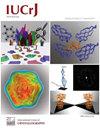Low-energy tetrahedral networks for carbon and silicon from (2+1)-regular bipartite-like graphs
IF 3.6
2区 材料科学
Q2 CHEMISTRY, MULTIDISCIPLINARY
引用次数: 0
Abstract
This study identifies carbon crystal structures as 4-degree quotient graphs and proposes a novel approach for generating 3D 4-coordinate networks using 2D (2+1)-regular bipartite-like graphs. Through a random group and graph theory (RG2) method, we discover 509 new structures, including two low-energy phases (Pbam48 and Pbam40) that exhibit exceptional stability and potential applications as superhard carbon and quasi-direct band gap silicon materials in mechanical processing and solar photovoltaic technologies.
Post-graphite in cold-compression [Mao et al. (2003). Science302, 425–427] has attracted widespread research interest in condensed matter physics. Subsequently, many low-energy carbon phases, such as M-carbon, W-carbon and Z-carbon, have been proposed as structural candidates. Based on graph theory, we found that these 4-coordinated post-graphite candidates can not only be decomposed into 3-regular graphitic graphs but also yield (2+1)-regular graphs in a non-graphitic manner from different decomposition directions. This inspires a general idea of generating 3D 4-coordinate networks based on 2D (2+1)-regular bipartite-like graphs, which can be efficiently generated by a random method combined with group and graph theory (RG2). Associated with such a general graph-based method, a large number of 4-coordinate networks have been discovered and investigated by first-principles calculations as potential carbon/silicon phases. Most are confirmed as low-energy carbon/silicon phases and identified as direct or quasi-direct band gap semiconductors. Two complex configurations, Pbam48 and Pbam40, show energetic stabilities exceeding or comparable to the previously proposed Pbam24. They are further confirmed to be dynamically and mechanically stable phases as carbon/silicon. As carbon phases, Pbam48 and Pbam40 are superhard insulators with quasi-direct band gaps of 5.622 and 5.890 eV, and hardness values of 85.352 and 85.558 GPa, respectively. Their X-ray diffraction (XRD) results can largely explain the experimental XRD patterns of cold-compressed graphite. As silicon allotropes, Pbam48 and Pbam40 have quasi-direct band gaps of 1.386 and 1.451 eV, respectively, making them potential solar cell absorber materials.
碳和硅的低能四面体网络,来自(2+1)规则双部分样图。
后石墨冷压缩[Mao et al.(2003)]。[科学]302,425-427]在凝聚态物理领域引起了广泛的研究兴趣。随后,许多低能碳相,如m -碳、w-碳和z -碳,被提出作为候选结构。基于图论,我们发现这4个配位后石墨候选物不仅可以分解为3个正则图,而且可以从不同的分解方向以非石墨的方式生成(2+1)个正则图。这激发了基于2D(2+1)正则双分图生成三维四坐标网络的一般思想,该网络可以通过结合群图理论(RG2)的随机方法有效地生成。与这种通用的基于图的方法相关联,通过第一性原理计算已经发现并研究了大量的4坐标网络作为潜在的碳/硅相。大多数被确认为低能量碳/硅相,并被确定为直接或准直接带隙半导体。两个复杂的结构,Pbam48和Pbam40,显示出能量稳定性超过或与先前提出的Pbam24相当。进一步证实了它们是与碳/硅一样动态和机械稳定的相。作为碳相,Pbam48和Pbam40为超硬绝缘子,准直接带隙分别为5.622和5.890 eV,硬度分别为85.352和85.558 GPa。它们的x射线衍射(XRD)结果在很大程度上解释了冷压缩石墨的实验XRD图谱。作为硅同素异素体,Pbam48和Pbam40的准直接带隙分别为1.386和1.451 eV,是潜在的太阳能电池吸收材料。
本文章由计算机程序翻译,如有差异,请以英文原文为准。
求助全文
约1分钟内获得全文
求助全文
来源期刊

IUCrJ
CHEMISTRY, MULTIDISCIPLINARYCRYSTALLOGRAPH-CRYSTALLOGRAPHY
CiteScore
7.50
自引率
5.10%
发文量
95
审稿时长
10 weeks
期刊介绍:
IUCrJ is a new fully open-access peer-reviewed journal from the International Union of Crystallography (IUCr).
The journal will publish high-profile articles on all aspects of the sciences and technologies supported by the IUCr via its commissions, including emerging fields where structural results underpin the science reported in the article. Our aim is to make IUCrJ the natural home for high-quality structural science results. Chemists, biologists, physicists and material scientists will be actively encouraged to report their structural studies in IUCrJ.
 求助内容:
求助内容: 应助结果提醒方式:
应助结果提醒方式:


